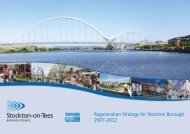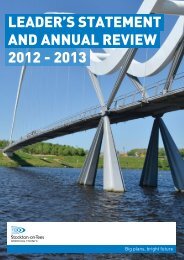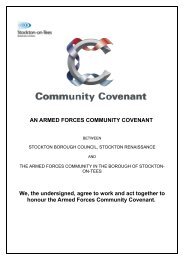Heritage Strategy - Stockton-on-Tees Borough Council
Heritage Strategy - Stockton-on-Tees Borough Council
Heritage Strategy - Stockton-on-Tees Borough Council
Create successful ePaper yourself
Turn your PDF publications into a flip-book with our unique Google optimized e-Paper software.
Chapter 2: Knowing our <str<strong>on</strong>g>Heritage</str<strong>on</strong>g><br />
Oil and chemical industry<br />
The first chemical works in the borough was opened in<br />
Urlay Nook, Eaglescliffe in 1833 by Robert Wils<strong>on</strong> to<br />
make Sulphuric Acid and fertiliser. This company<br />
c<strong>on</strong>verted to producing Chromium Chemicals in the 20th<br />
century finally becoming known as Elementis. The works<br />
recently closed.<br />
The discovery of salt at Port Clarence in the 1870s was<br />
important for the later chemical industries of the area.<br />
However, it was the First World War, which brought the<br />
need for explosives, and a new works was opened in<br />
<str<strong>on</strong>g>Stockt<strong>on</strong></str<strong>on</strong>g> by the government, The <str<strong>on</strong>g>Stockt<strong>on</strong></str<strong>on</strong>g> Chemical<br />
Works making TNT. After the War the works was sold to<br />
Athole G Allen who c<strong>on</strong>tinued producing TNT and also<br />
diversified into producing Barium based chemicals using<br />
raw materials from <strong>Tees</strong>dale. This works c<strong>on</strong>tinued<br />
through World War Two, finally closing in the 1960s.<br />
The First World War also saw the development of a new<br />
chemical works in Billingham. At the end of the War a<br />
new company called Synthetic Amm<strong>on</strong>ia & Nitrates,<br />
known locally as the “Synthetic” bought the site. This<br />
company became part of the newly formed Imperial<br />
Chemical Industries in 1926.<br />
With the growing importance of oil and the offshore<br />
drilling of North Sea oil, a large petrochemical industry<br />
including an oil refinery and numerous chemical works<br />
were set up in the area. This industry is still an important<br />
part of the ec<strong>on</strong>omy of the <strong>Borough</strong>.<br />
imperial chemical industries<br />
In 1917, the government was looking for sites to build a<br />
plant to produce amm<strong>on</strong>ia. A large site at Billingham was<br />
eventually chosen, however, the First World War ended<br />
before much of the site had been c<strong>on</strong>structed and it was<br />
put up for sale. The Brunner M<strong>on</strong>d Company set up a<br />
new company Synthetic Amm<strong>on</strong>ia and Nitrates to buy<br />
the site and new plants were c<strong>on</strong>structed. The site was<br />
close to the railway to import coal from the Durham<br />
coalfield, there was a salt industry nearby at Port Clarence<br />
and Havert<strong>on</strong> Hill and there was anhydrite under the site.<br />
In 1926 this company became part of the newly formed<br />
company Imperial Chemical Industries Limited.<br />
The works expanded rapidly, mining Anhydrite for<br />
fertilisers, producing Sodium and Chlorine from Salt and<br />
producing plasterboard and cement as byproducts. The<br />
petrol from coal plant had opened in the 1930s and this<br />
proved a very important source of High-Octane aircraft<br />
fuel in World War Two. A plant also produced perspex for<br />
aircraft cockpits. Billingham was the centre for the “Tube<br />
Alloys” project which was the British code name for their<br />
work <strong>on</strong> the development of the atomic bomb.<br />
After the War the plant expanded further until the site<br />
was at capacity and ICI found a new site at Wilt<strong>on</strong> over<br />
the river <strong>Tees</strong>. With the growing importance of oil and<br />
the discovery of North Sea oil a joint venture oil refinery<br />
was built at North <strong>Tees</strong>. New products included an animal<br />
feedstuff made synthetically and eventually a new meat<br />
substitute for human c<strong>on</strong>sumpti<strong>on</strong>, Quorn.<br />
As worldwide competiti<strong>on</strong> grew ICI diversified and sold<br />
off its various business interests.<br />
One of our most important assets are<br />
our bridges…..<br />
• Yarm Bridge and Viaduct<br />
• Transporter Bridge<br />
• Newport Bridge<br />
• Infinity Bridge<br />
• Victoria Bridge<br />
• Princess Diana Bridge<br />
• Millennium Bridge<br />
Newport Bridge Millennium Bridge Infinity Bridge<br />
32

















